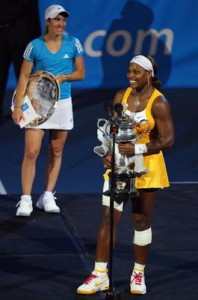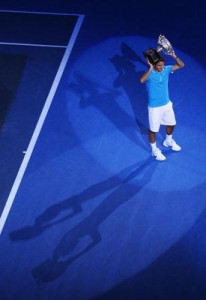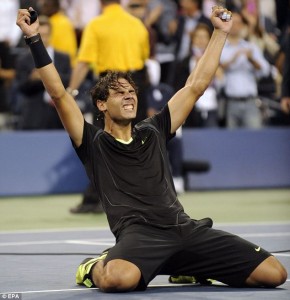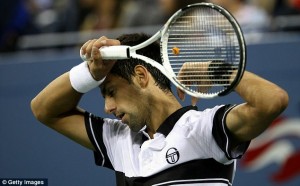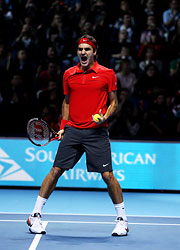Ranking Tennis in 2010: The Top 10 Performances, Part 2
No. 5: Serena Williams Fights Off the Henin Challenge
Serena Williams defeats Justine Henin: 2010 Australian Open Final
Was there ever a more anticipated final in women’s tennis than this one?
Perhaps in the past when Chris Evert met Martina Navratilova or Steffi Graf met Monica Seles before the 1993 stabbing.
With the exception of the French Open, in recent tennis history Serena Williams loomed as a juggernaut with her stranglehold on slam trophies.
But Justine Henin was a winner in her own right.
Henin, when ranked No. 1 in women’s tennis, abruptly retired from the game just prior to the 2008 French Open.
Now, the Belgian was back 19 months later, unseeded and unranked, to play the World No. 1 in the finals of the Australian Open.
The tennis world was abuzz at the Belgian’s rise from the ashes.
Henin, however, did not have enough weapons on the day––especially against the William’s serve to hold onto her advantage after the Belgian took the second set to even the match at one set apiece.
Henin earned break points against Serena in the third set, game two, but could only watch as Serena served rockets that skipped past her. The Belgian’s spirit broken, Williams closed in out 6-2-3-6, 6-2.
Serena Williams equalled the record of Billie Jean King by winning this match, drawing her ever closer to legendary status.
Serena with 12 slam titles at this point was awarded her trophy by Margaret Court who leads all slam champions with 24 singles grand slam titles.
No. 4: Federer Extends His Dominance Down Under
Roger Federer defeats Andy Murray: 2010 Australian Open Final
The way Andy Murray stormed into the final, sweeping aside all opposition, pundits remained convinced that this would be the Scot’s finest hour and he would finally scoop up that elusive prize, a grand slam crown.
The man who stood across the net was the man who always seemed to be blocking Murray’s way in grand slam contests, Roger Federer.
It was Federer who turned him away at the U.S. Open in 2008, overcoming the Scot in straight sets.
Roger Federer dismissed Murray again in straight sets, but the final set was a struggle going to a tie break with numerous opportunities for the Scot to gain the advantage as the point count climbed to 24.
In the end, Murray could not overcome the determination of Federer to score slam No. 16, giving the Swiss a little breathing space as he distanced himself from Pete Sampras holding steady at 14.
It appeared to all the tennis world that this was going to be another Federer year because his play was so spectacular and deadly in Australia.
Inexplicably, it did not turn out that way for Federer.
Even so, this was a significant victory, setting another record as Federer won slam No. 16.
Will anyone else ever reach 16? Will Federer be able to add to this total?
These are questions awaiting as 2011 unfolds ahead.
No. 3: Nadal Conquers on the Fastest Cement
2010 US Open: Rafael Nadal Wins his last Slam
The U.S. Open stood as the only pinnacle left in the Nadal list of major conquests.
Not only had Nadal never won the U.S. Open, he had never made it as far as the finals.
Even to consider that Nadal would be playing for this third consecutive slam trophy in 2010 seemed very unlikely if you looked back at the beginning of the year when Nadal wrenched his knee in a match with Murray during the Australian Open.
After spending the greater part of 2009 suffering from tendinitis, many had written off the Majorcan, convinced his knees would never hold up and allow him to regain the No. 1 ranking.
This was especially true after Federer dominated at the 2010 Australian Open.
After winning both the French Open and Wimbledon in 2010, Nadal moved on to the U.S. Open where the nay-sayers assembled once again sure that Nadal could never win on the fast hard courts at Flushing Meadows.
Only the foolish discount the Majorcan once he has made up his mind to up his game in order to conquer a new surface.
With Murray losing early opening up his side of the draw, Nadal’s semifinal opponent turned out to be the unpredictable Russian Mikhail Youzhny. But Nadal dismissed Youzhny 6-2, 6-3, 6-4.
The other semifinal, however, pitted Novak Djokovic against Roger Federer and that semifinal turned into a five-set thriller with the Serb finally coming out the winner 5-7, 6-1, 5-7, 6-2, 7-5.
Djokovic had not been in a major final since he won the Australian Open in 2008.
The weather, however, wreaked havoc with the finals, postponing the men’s final from Sunday to Monday.
This gave Djokovic another day of rest after his long and tense semifinal match with Federer.
Djokovic was broken in the first game of the match after the opening point took 21 strokes.
Not a very auspicious beginning for the Serb. But Djokovic broke right back to even the first set at 1-1.
The Serb sealed his first set defeat by losing the fifth game on his own serve. Nadal won the first set.
When the Majorcan wins the first set of a grand slam, Nadal almost never loses. He has won 107 of 108 matches when he wins the first set of a grand slam.
Djokovic came back strong in the second set, going out to a 4-1 lead. But Nadal did not give up and fought back. Then the rains came delaying the match for almost two hours.
When the players came back, Djokovic found his timing and took the second set 7-5.
Nadal kept Djokovic under constant pressure as the Serb faced break point after break point––more than 20 in the match.
To his credit Djokovic staved off most of them but not enough to save the match. Add to that Nadal’s improved serve and his ability to hold his own serve, and you understand why Nadal won 6-4, 5-7, 6-4, 6-2.
It marked full equality for Nadal. He long ago gave up the mantle of clay-court specialist and became a man for all surfaces.
By winning the U.S. Open, Nadal became the seventh man to win a career grand slam joining Don Budge, Fred Perry, Rod Laver, Roy Emerson, Andre Agassi and Roger Federer. He also won his ninth grand slam title, passing Jimmy Connors, Ivan Lendl. Ken Rosewall and Andre Agassi with eight.
No. 2: Roger Federer Rises from the Ashes
2010 World Tour Finals: Roger Federer v. Rafael Nadal
It adds to the 2010 symmetry, having Roger Federer begin and end the year with awesome displays of dominance.
The European indoor season gave the Swiss some impetus coming into the WTF in London as Federer won the Stockholm Open followed by the Swiss Indoors recapturing the title at his home town tournament.
After starting the year by winning his 16th grand slam at the Australian Open, Federer failed to recapture either the French Open or Wimbledon crowns as the defending champion.
After failing to make the semifinals at Roland Garros, Federer lost his No. 1 ranking to Rafael Nadal who returned to form on the European clay.
But now, he came into London with some confidence and a new coach, Paul Annacone who may have helped the Maestro regain his finesse and form exhibiting new-found confidence.
The top eight players met in London in late November to play for the World Tour Finals Championship utilizing the traditional round-robin format established for this tournament back in the 1970s when it was first played.
Federer’s group included Andy Murray, Robin Soderling and David Ferrer while Nadal’s group contained Novak Djokovic, Tomas Berdych and Andy Roddick.
Both Nadal and Federer went undefeated in the round robin portion of their draw. In the semifinals, Federer faced Djokovic while Murray took on Nadal.
While Federer dismissed Djokovic 6-1, 6-4 on semifinal Saturday in 80 minutes, Nadal had to fight off a very determined Andy Murray in a classic match that lasted three hours, eleven minutes.
During that time, nothing came easily including dealing with the high tension throughout the match which ended in Nadal’s favor 7-6, 3-6, 7-6.
The finals on Sunday pitted the two top-ranked players in the world, finally. The world took notice, filling the stands and tuning in.
Federer took the first set, breaking Nadal immediately when the Swiss gained a break chance with Nadal serving at 3-4. Federer’s serve remain impeccable as he delivered three aces, giving up only three points on his serve in the opening set.
Nadal, however, upped his game in the second set as Federer’s serve ceased hitting the marks. The Majorcan shot out to a 4-1 lead.
Even though Federer picked up his pace after dropping service, the Swiss could not deliver a break back. Federer lost the second set.
Appropriately, the match would be decided in a third and final set.
Federer remained aggressive, taking the ball early, denying Nadal enough time to perfect his shots.
It paid dividends in the third set as Federer took a 3-1 lead, breaking Nadal in the fourth game of the set.
Then, despite a relentless charge from Nadal, Federer hung on to go up 4-1.
The match ended as Nadal’s game folded under the constant pressure exerted by Federer 6-3, 3-6, 6-1, lasting an hour and 38 minutes.
Federer won his fifth ATP year-end championship and his 66th ATP Title.
His previous titles came in 2003 when he defeated Andre Agassi. He defeated Lleyton Hewitt in 2004, James Blake in 2006, and David Ferrer in 2007.
Federer ties former World No. 1 Pete Sampras and Ivan Lendl with five championships.
The win achieved many objectives for the World No. 2. Federer reestablished a degree of belief in his game by his peers and his fans as well as the ever-negative sports pundits. The points brought him closer to Nadal and closer to perhaps recapturing that No. 1 ranking.
It also demonstrated that the rivalry is still alive and that Federer is capable of changing his game and rising up to defeat Nadal.
No. 1: Resurrection on the Red Dirt
2010 Nadal’s Clay Court Season
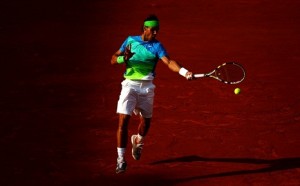
Rafael Nadal's clay court season in 2010 was amazing ending with the recapture of the French Open crown.
While it seems inappropriate to lump together a season in tennis as one event, it is highly apropos when you analyze the most amazing clay season ever put together by one man, Majorcan Rafael Nadal.
After fading badly in 2009 with many tennis prognosticators announcing Nadal was finished, the Majorcan came back during the clay season of 2010 stronger than ever.
It began in Monte Carlo. He defeated countryman Fernando Verdasco in straight sets 6-0, 6-1 hardly breaking a sweat. His victory gave Nadal six consecutive wins at the same tournament, a feat no one had yet accomplished in the Open Era.
Nadal reluctantly skipped Barcelona where he held five consecutive titles, opting to head straight to Rome where all roads lead, awaiting the next ATP 1000 tournament.
There he blew away the opposition until the semis where Nadal faced Ernests Gulbis who had excused Roger Federer from the proceedings in the round of 32. Gulbis extended Nadal to 3 sets for the first time in the clay season but Nadal held on and won the match 6-4, 3-6, 6-4.
The Majorcan refused to lose. David Ferrer, Nadal’s compatriot, fought his way into the final as well. But in the end, Nadal won 7-5, 6-2 defeating Ferrer and in the process winning his seventeenth Masters title, equalling the record held by Andre Agassi for so many years.
Nadal went on to Madrid where he was not the reigning champion. That honor belonged to Roger Federer. It seemed only fitting that the two should meet again in the finals. This time, however, Nadal prevailed, winning 6-4, 7-6.
The win in Madrid was significant, astounding really even for the man who appears to be the greatest clay court player in the history of the game because in the process Nadal broke several records.
He won his 18th Masters title, giving him the all-time record alone, one more than Agassi.
Nadal became the first player ever to win all three Masters 1000 shields in a single season as well as winning three consecutive Masters titles. No one had ever accomplished that before. The only man seemingly capable of repeating the feat is Nadal himself.
This is the Number One performance in 2010. Nadal’s resurrection on clay marked the beginning of one of the most remarkable seasons in the history of men’s tennis.
